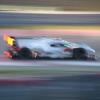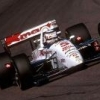I seem to remember that additional panic was created in 1994 with the idea that Honda, already dipping their toe in, would come back in 1995 with a similar motor to take the fight to Penske, and given the emotions of the era (which led to the Split), that was not something that anyone wanted to see happen.
But I could be totally wrong here.
Not only Honda, Ford was also forced to think about such a project and Menard was also already working on a V8 to replace its V6.
For CART engine builders, it would have lead to the situation that they had to create two entirely different engine programs, one for the CART season, one for Indy only. Unless CART would have given in on requests already made in the past by teams running Buicks to give the these V6's na now all pushrod engines the same boost increase as they had at Indy. CART did allow pushrod engines like the Buick but they didn't have a higher turboboost like they had at Indy. All engines in CART used the same boost levels, making the Buick's near useless within CART. Now had this boost advantage also be given by CART then everyone could drop these Quadcam 2.65 liter engines and concentrate on the pushrod engines like the Ilmor and Greenfield instead.
And that would have taken away the advantage USAC had hoped to create to encourage smaller engine builders. Not mentioning the fact that CART racing cars all of a sudden would see a power increase of way over 150 hp, in a time that CART tried to find manners to slow the cars down a bit.
Another thing for CART was that the '94 Penske chassis úsed at Indy wasn't a bespoke design to be fitted with the 265E from the outset. The car was designed for the regular 2.65 liter Quadcam Ilmor 265\D. But for Indy that engine was replaced with the 265\E. Some parts in the driveline were beefed up and adjusted for the more powerful engine but Team Penske had not designed let alone built a bespoke chassis to make optimal use of whatever the 265\E had to offer. That would have been the next step for improvement: building a bespoke chassis for Indy-only for the Indy-only engine
Anyway, Costs would have gone skyhigh for the engine builders and the lease prizes to the teams for engineswould have gone up. And for USAC, the idea to give the smaller teams a better chance with a new option made up for them was gone once Ilmor was building such engines. Because Ilmor only awarded engines to teams the wanted to supply. Even if you had enough money to lease them, Ilmor was restricted in capacity and could not make engines readily available to everyone as in the days of the (Ford) Cosworth DFX in the late 80s and later on in the 90s when the Ford Cosworth XB became available. Chevrolet got a lot of bad publicity about that because many felt that since their engine was the dominant one but not avaialble to anyone who wanted it and could afford it they killed the racing. Certainly in 1991 that was causling a lot of anger, curiously, just after CART had managed to drive away Porsche out of CART !!!!
The info told about 1995 plans for Ilmor was that their CART teams got the chance to sign up for the use of the latest versions of the 265\E. But it required yet another extra 1 milloin dollar to fond for that program. It was not that if a team got a lease for Ilmor engines for 1995 that they got the 265\E (or whatever name the 2nd generation engine would have had) was part of the deal. That was a separate deal that required extra money.
Needless to say, any other team that only wanted to sign up for the 265\E engine deal for Indy was kindly told that this was not possible.
Once USAC found out about these plans, the story is that it convinced them even more that their plan to help the little guys out had failed miserably ant the best option being making their own invention no longer able to dominate at will. It was the best thing they could do.
Edited by Henri Greuter, 07 May 2020 - 17:46.





























